B10597 Financial Accounting Assignment: Statements and Ratios
VerifiedAdded on 2023/01/12
|18
|3444
|86
Homework Assignment
AI Summary
This financial accounting assignment provides a comprehensive overview of key accounting concepts and practices. It begins with an introduction to business transactions and double-entry bookkeeping, followed by a detailed analysis of a trial balance, including the calculation of owner's capital. The assignment then delves into ledger accounts, providing examples for various transactions such as purchases, sales, and expenses. It also presents an income statement and balance sheet, illustrating how to prepare financial statements for a company, including the calculation of net profit and financial position. Furthermore, the assignment covers bank reconciliation statements and the calculation and interpretation of financial ratios, such as return on capital employed, gross profit margin, and gearing ratio, providing a holistic understanding of financial accounting principles and their application.

B10597
FINANCIAL
ACCOUNTING
FINANCIAL
ACCOUNTING
Paraphrase This Document
Need a fresh take? Get an instant paraphrase of this document with our AI Paraphraser
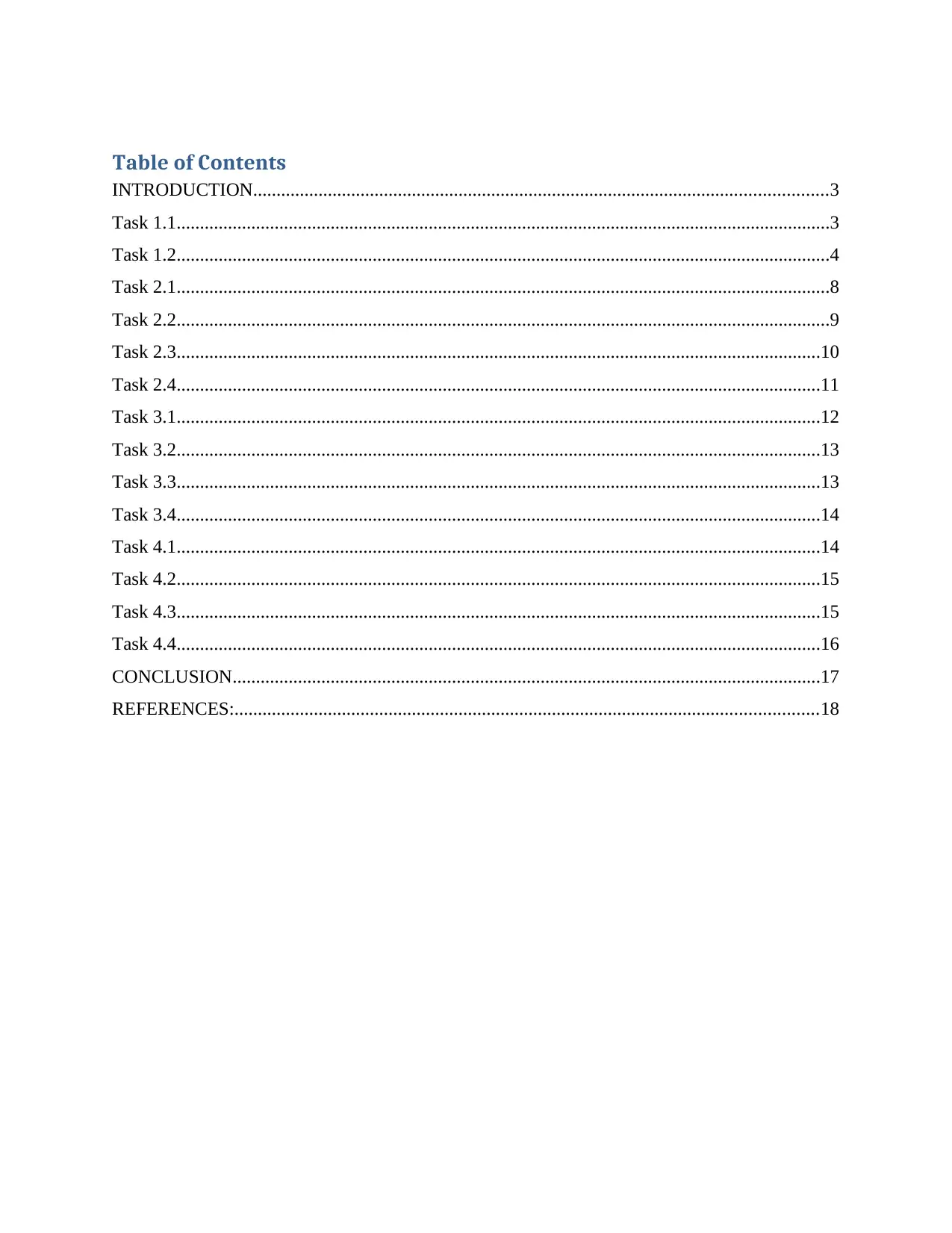
Table of Contents
INTRODUCTION...........................................................................................................................3
Task 1.1............................................................................................................................................3
Task 1.2............................................................................................................................................4
Task 2.1............................................................................................................................................8
Task 2.2............................................................................................................................................9
Task 2.3..........................................................................................................................................10
Task 2.4..........................................................................................................................................11
Task 3.1..........................................................................................................................................12
Task 3.2..........................................................................................................................................13
Task 3.3..........................................................................................................................................13
Task 3.4..........................................................................................................................................14
Task 4.1..........................................................................................................................................14
Task 4.2..........................................................................................................................................15
Task 4.3..........................................................................................................................................15
Task 4.4..........................................................................................................................................16
CONCLUSION..............................................................................................................................17
REFERENCES:.............................................................................................................................18
INTRODUCTION...........................................................................................................................3
Task 1.1............................................................................................................................................3
Task 1.2............................................................................................................................................4
Task 2.1............................................................................................................................................8
Task 2.2............................................................................................................................................9
Task 2.3..........................................................................................................................................10
Task 2.4..........................................................................................................................................11
Task 3.1..........................................................................................................................................12
Task 3.2..........................................................................................................................................13
Task 3.3..........................................................................................................................................13
Task 3.4..........................................................................................................................................14
Task 4.1..........................................................................................................................................14
Task 4.2..........................................................................................................................................15
Task 4.3..........................................................................................................................................15
Task 4.4..........................................................................................................................................16
CONCLUSION..............................................................................................................................17
REFERENCES:.............................................................................................................................18
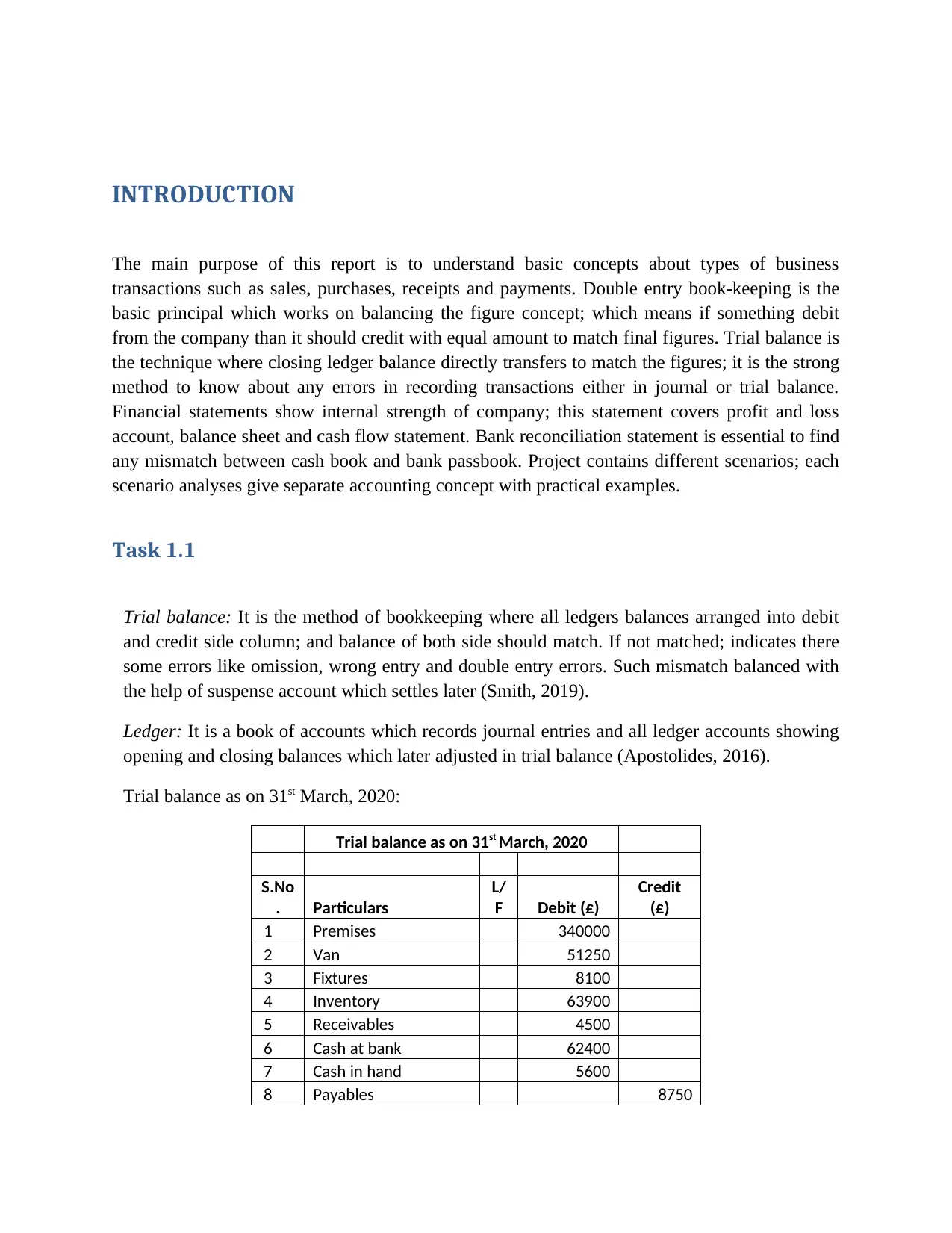
INTRODUCTION
The main purpose of this report is to understand basic concepts about types of business
transactions such as sales, purchases, receipts and payments. Double entry book-keeping is the
basic principal which works on balancing the figure concept; which means if something debit
from the company than it should credit with equal amount to match final figures. Trial balance is
the technique where closing ledger balance directly transfers to match the figures; it is the strong
method to know about any errors in recording transactions either in journal or trial balance.
Financial statements show internal strength of company; this statement covers profit and loss
account, balance sheet and cash flow statement. Bank reconciliation statement is essential to find
any mismatch between cash book and bank passbook. Project contains different scenarios; each
scenario analyses give separate accounting concept with practical examples.
Task 1.1
Trial balance: It is the method of bookkeeping where all ledgers balances arranged into debit
and credit side column; and balance of both side should match. If not matched; indicates there
some errors like omission, wrong entry and double entry errors. Such mismatch balanced with
the help of suspense account which settles later (Smith, 2019).
Ledger: It is a book of accounts which records journal entries and all ledger accounts showing
opening and closing balances which later adjusted in trial balance (Apostolides, 2016).
Trial balance as on 31st March, 2020:
Trial balance as on 31st March, 2020
S.No
. Particulars
L/
F Debit (£)
Credit
(£)
1 Premises 340000
2 Van 51250
3 Fixtures 8100
4 Inventory 63900
5 Receivables 4500
6 Cash at bank 62400
7 Cash in hand 5600
8 Payables 8750
The main purpose of this report is to understand basic concepts about types of business
transactions such as sales, purchases, receipts and payments. Double entry book-keeping is the
basic principal which works on balancing the figure concept; which means if something debit
from the company than it should credit with equal amount to match final figures. Trial balance is
the technique where closing ledger balance directly transfers to match the figures; it is the strong
method to know about any errors in recording transactions either in journal or trial balance.
Financial statements show internal strength of company; this statement covers profit and loss
account, balance sheet and cash flow statement. Bank reconciliation statement is essential to find
any mismatch between cash book and bank passbook. Project contains different scenarios; each
scenario analyses give separate accounting concept with practical examples.
Task 1.1
Trial balance: It is the method of bookkeeping where all ledgers balances arranged into debit
and credit side column; and balance of both side should match. If not matched; indicates there
some errors like omission, wrong entry and double entry errors. Such mismatch balanced with
the help of suspense account which settles later (Smith, 2019).
Ledger: It is a book of accounts which records journal entries and all ledger accounts showing
opening and closing balances which later adjusted in trial balance (Apostolides, 2016).
Trial balance as on 31st March, 2020:
Trial balance as on 31st March, 2020
S.No
. Particulars
L/
F Debit (£)
Credit
(£)
1 Premises 340000
2 Van 51250
3 Fixtures 8100
4 Inventory 63900
5 Receivables 4500
6 Cash at bank 62400
7 Cash in hand 5600
8 Payables 8750
⊘ This is a preview!⊘
Do you want full access?
Subscribe today to unlock all pages.

Trusted by 1+ million students worldwide
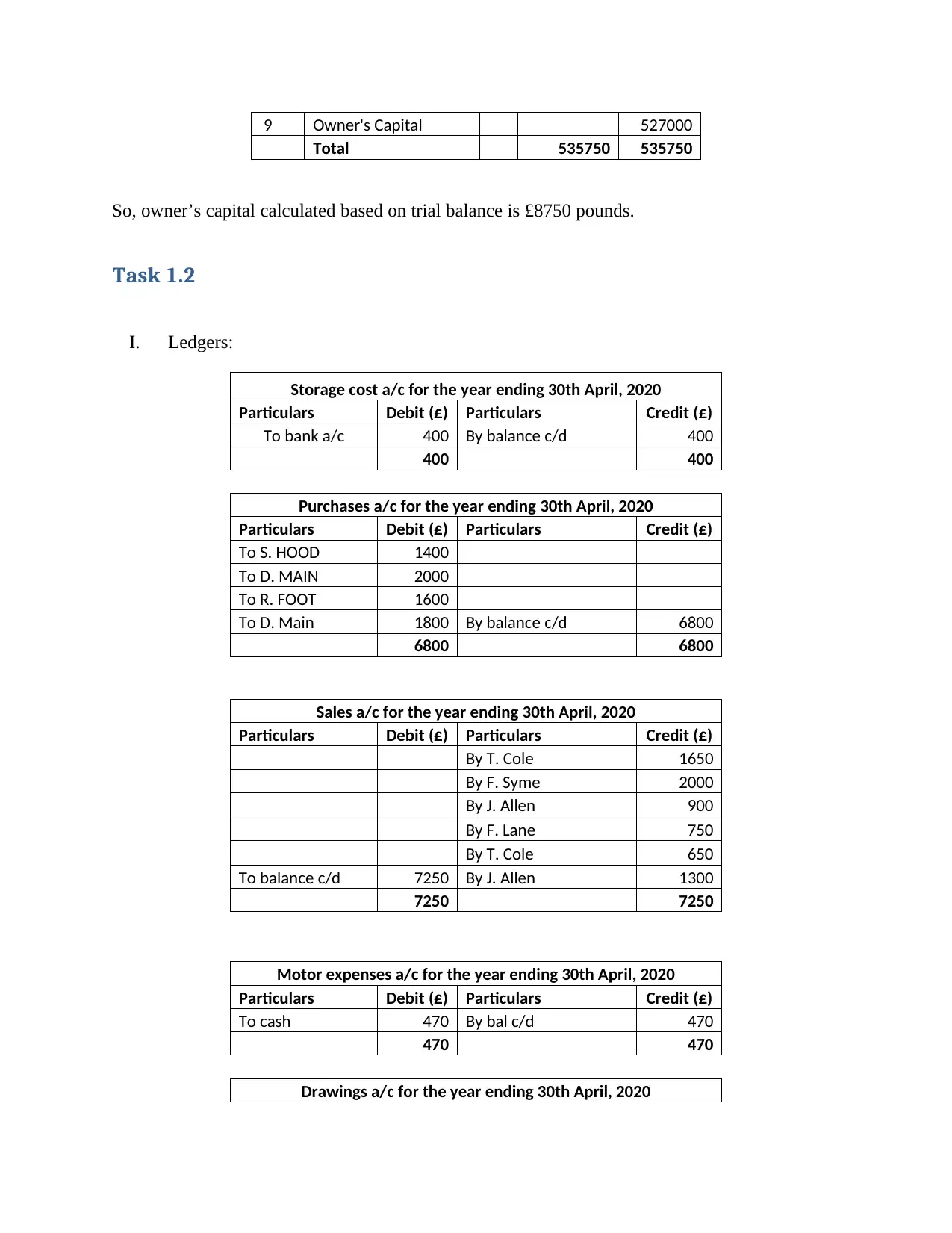
9 Owner's Capital 527000
Total 535750 535750
So, owner’s capital calculated based on trial balance is £8750 pounds.
Task 1.2
I. Ledgers:
Storage cost a/c for the year ending 30th April, 2020
Particulars Debit (£) Particulars Credit (£)
To bank a/c 400 By balance c/d 400
400 400
Purchases a/c for the year ending 30th April, 2020
Particulars Debit (£) Particulars Credit (£)
To S. HOOD 1400
To D. MAIN 2000
To R. FOOT 1600
To D. Main 1800 By balance c/d 6800
6800 6800
Sales a/c for the year ending 30th April, 2020
Particulars Debit (£) Particulars Credit (£)
By T. Cole 1650
By F. Syme 2000
By J. Allen 900
By F. Lane 750
By T. Cole 650
To balance c/d 7250 By J. Allen 1300
7250 7250
Motor expenses a/c for the year ending 30th April, 2020
Particulars Debit (£) Particulars Credit (£)
To cash 470 By bal c/d 470
470 470
Drawings a/c for the year ending 30th April, 2020
Total 535750 535750
So, owner’s capital calculated based on trial balance is £8750 pounds.
Task 1.2
I. Ledgers:
Storage cost a/c for the year ending 30th April, 2020
Particulars Debit (£) Particulars Credit (£)
To bank a/c 400 By balance c/d 400
400 400
Purchases a/c for the year ending 30th April, 2020
Particulars Debit (£) Particulars Credit (£)
To S. HOOD 1400
To D. MAIN 2000
To R. FOOT 1600
To D. Main 1800 By balance c/d 6800
6800 6800
Sales a/c for the year ending 30th April, 2020
Particulars Debit (£) Particulars Credit (£)
By T. Cole 1650
By F. Syme 2000
By J. Allen 900
By F. Lane 750
By T. Cole 650
To balance c/d 7250 By J. Allen 1300
7250 7250
Motor expenses a/c for the year ending 30th April, 2020
Particulars Debit (£) Particulars Credit (£)
To cash 470 By bal c/d 470
470 470
Drawings a/c for the year ending 30th April, 2020
Paraphrase This Document
Need a fresh take? Get an instant paraphrase of this document with our AI Paraphraser

Particulars Debit (£) Particulars Credit (£)
To Capital a/c 1500 By bal c/d 1500
1500 1500
Van a/c for the year ending 30th April, 2020
Particulars Debit (£) Particulars Credit (£)
To Balance b/d 51250
To Abdel Motors 28500 By Bal c/d 79750
79750 79750
Salaries a/c for the year ending 30th April, 2020
Particulars Debit (£) Particulars Credit (£)
To bank a/c 4800 By bal c/d 4800
4800 4800
Business rates a/c for the year ending 30th April, 2020
Particulars Debit (£) Particulars Credit (£)
To Bank 1320 By bal c/d 1320
1320 1320
Cash a/c for the year ending 30th April, 2020
Particulars Debit (£) Particulars Credit (£)
To Bal b/d 5600 By Motor expenses 470
By bal c/d 5130
5600 5600
Bank a/c for the year ending 30th April, 2020
Particulars Debit (£) Particulars Credit (£)
To Bal b/d 62400 By Storage expenses 400
To P. Mullen 1400 By S. Hood 2150
To F. Lane 3100 By J. Brown 4600
To F. Syme 2000 By R. Foot 1400
By Salaries 4800
By business rates 1320
By Abel Motors 28500
By balance c/d 25730
68900 68900
S. Hood a/c for the year ending 30th April, 2020
Particulars Debit (£) Particulars Credit (£)
To Bank 2150 By balance b/d 2150
To bal c/d 1400 By Purchases 1400
To Capital a/c 1500 By bal c/d 1500
1500 1500
Van a/c for the year ending 30th April, 2020
Particulars Debit (£) Particulars Credit (£)
To Balance b/d 51250
To Abdel Motors 28500 By Bal c/d 79750
79750 79750
Salaries a/c for the year ending 30th April, 2020
Particulars Debit (£) Particulars Credit (£)
To bank a/c 4800 By bal c/d 4800
4800 4800
Business rates a/c for the year ending 30th April, 2020
Particulars Debit (£) Particulars Credit (£)
To Bank 1320 By bal c/d 1320
1320 1320
Cash a/c for the year ending 30th April, 2020
Particulars Debit (£) Particulars Credit (£)
To Bal b/d 5600 By Motor expenses 470
By bal c/d 5130
5600 5600
Bank a/c for the year ending 30th April, 2020
Particulars Debit (£) Particulars Credit (£)
To Bal b/d 62400 By Storage expenses 400
To P. Mullen 1400 By S. Hood 2150
To F. Lane 3100 By J. Brown 4600
To F. Syme 2000 By R. Foot 1400
By Salaries 4800
By business rates 1320
By Abel Motors 28500
By balance c/d 25730
68900 68900
S. Hood a/c for the year ending 30th April, 2020
Particulars Debit (£) Particulars Credit (£)
To Bank 2150 By balance b/d 2150
To bal c/d 1400 By Purchases 1400
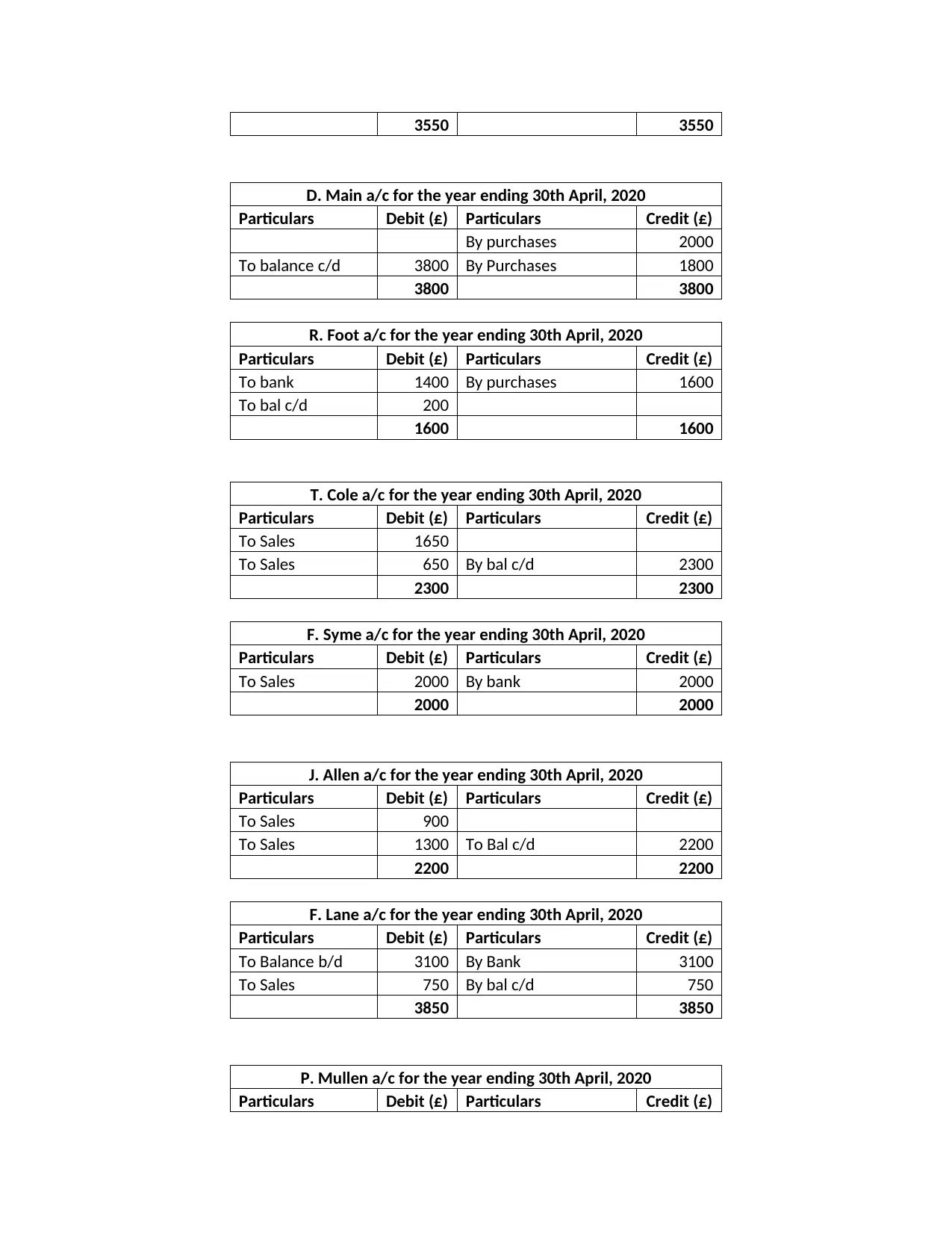
3550 3550
D. Main a/c for the year ending 30th April, 2020
Particulars Debit (£) Particulars Credit (£)
By purchases 2000
To balance c/d 3800 By Purchases 1800
3800 3800
R. Foot a/c for the year ending 30th April, 2020
Particulars Debit (£) Particulars Credit (£)
To bank 1400 By purchases 1600
To bal c/d 200
1600 1600
T. Cole a/c for the year ending 30th April, 2020
Particulars Debit (£) Particulars Credit (£)
To Sales 1650
To Sales 650 By bal c/d 2300
2300 2300
F. Syme a/c for the year ending 30th April, 2020
Particulars Debit (£) Particulars Credit (£)
To Sales 2000 By bank 2000
2000 2000
J. Allen a/c for the year ending 30th April, 2020
Particulars Debit (£) Particulars Credit (£)
To Sales 900
To Sales 1300 To Bal c/d 2200
2200 2200
F. Lane a/c for the year ending 30th April, 2020
Particulars Debit (£) Particulars Credit (£)
To Balance b/d 3100 By Bank 3100
To Sales 750 By bal c/d 750
3850 3850
P. Mullen a/c for the year ending 30th April, 2020
Particulars Debit (£) Particulars Credit (£)
D. Main a/c for the year ending 30th April, 2020
Particulars Debit (£) Particulars Credit (£)
By purchases 2000
To balance c/d 3800 By Purchases 1800
3800 3800
R. Foot a/c for the year ending 30th April, 2020
Particulars Debit (£) Particulars Credit (£)
To bank 1400 By purchases 1600
To bal c/d 200
1600 1600
T. Cole a/c for the year ending 30th April, 2020
Particulars Debit (£) Particulars Credit (£)
To Sales 1650
To Sales 650 By bal c/d 2300
2300 2300
F. Syme a/c for the year ending 30th April, 2020
Particulars Debit (£) Particulars Credit (£)
To Sales 2000 By bank 2000
2000 2000
J. Allen a/c for the year ending 30th April, 2020
Particulars Debit (£) Particulars Credit (£)
To Sales 900
To Sales 1300 To Bal c/d 2200
2200 2200
F. Lane a/c for the year ending 30th April, 2020
Particulars Debit (£) Particulars Credit (£)
To Balance b/d 3100 By Bank 3100
To Sales 750 By bal c/d 750
3850 3850
P. Mullen a/c for the year ending 30th April, 2020
Particulars Debit (£) Particulars Credit (£)
⊘ This is a preview!⊘
Do you want full access?
Subscribe today to unlock all pages.

Trusted by 1+ million students worldwide

To Balance b/d 1400 By Bank 1400
1400 1400
J. Brown a/c for the year ending 30th April, 2020
Particulars Debit (£) Particulars Credit (£)
To Bank 4600 By balance b/d 4600
4600 4600
Abdel Motors a/c for the year ending 30th April, 2020
Particulars Debit (£) Particulars Credit (£)
To Bank 28500 By Van 28500
28500 28500
II. Trial balance as on 30th April, 2020
Trial balance as on 30th April, 2020
S.No. Particulars L/F Debit (£) Credit (£)
1 Sales 7250
2 Purchases 6800
3 Premises 340000
4 Van 79750
5 Fixtures 8100
6 Inventory 63900
7 Receivables 5250
8 Cash at bank 25730
9 Cash in hand 5130
10 Payables 5400
11 Storage cost 400
12 Motor expenses 470
13 Drawings 1500
14 Salaries 4800
15 Business rates 1320
16 Owner's Capital 530500
Total 543150 543150
III. Analyzing Trial balance of 31st March, 2020 and 30th April, 2020
On the basis of transaction analysis of both trial balances following changes found:
Payables: Variation in payables in both trial balance shows difference of £3350;
this shows company has paid their creditors and thus showing cash out.
1400 1400
J. Brown a/c for the year ending 30th April, 2020
Particulars Debit (£) Particulars Credit (£)
To Bank 4600 By balance b/d 4600
4600 4600
Abdel Motors a/c for the year ending 30th April, 2020
Particulars Debit (£) Particulars Credit (£)
To Bank 28500 By Van 28500
28500 28500
II. Trial balance as on 30th April, 2020
Trial balance as on 30th April, 2020
S.No. Particulars L/F Debit (£) Credit (£)
1 Sales 7250
2 Purchases 6800
3 Premises 340000
4 Van 79750
5 Fixtures 8100
6 Inventory 63900
7 Receivables 5250
8 Cash at bank 25730
9 Cash in hand 5130
10 Payables 5400
11 Storage cost 400
12 Motor expenses 470
13 Drawings 1500
14 Salaries 4800
15 Business rates 1320
16 Owner's Capital 530500
Total 543150 543150
III. Analyzing Trial balance of 31st March, 2020 and 30th April, 2020
On the basis of transaction analysis of both trial balances following changes found:
Payables: Variation in payables in both trial balance shows difference of £3350;
this shows company has paid their creditors and thus showing cash out.
Paraphrase This Document
Need a fresh take? Get an instant paraphrase of this document with our AI Paraphraser

Receivables: The debtors closing account shows the variation of £750 decreases
from previous month; here cash is coming to business (Carey, Knowles &
Towers-Clark, 2017).
Cash at bank: Companies bank balance has decreased to £36670; due to
purchasing of Van and payment to creditors during month.
Cash in hand: Company has paid salaries and storage cost which has decreased
cash balance by £470
Total balance: As on 31st March, 2020 trial balance shows balancing figure of
£535750 and on 30th April, 2020 it has increased to £543150; also owner’s capital
increased with approx. £10000 pounds due because of raise in sales revenue,
Purchases and Van amount.
Task 2.1
Financial Accounting Statement: These are the progression statement of every company
which shows how efficiently its assets and strategies work for earning profit. The main
purpose behind preparing financial accounting statement is to show financial performance and
positions of the company. Some of financial statements include balance sheet, income
statement, cash flows and owner’s equity (Breton, 2018).
Comparison of different financial statements:
Bases Balance sheet Income statement Cash flow statements
Purpose It is prepared mainly
for showing financial
position of the
company. To know
how much debt and
equity own by
company (Tracy,
2016).
It is mainly prepared
to know total earnings
receive by
organization during a
year.
It has internal use by
companies management
staff to know financial
strength of company to
carry new operations.
Structure Balance sheet is
matching concept
where Total assets
should match with
Equity and liabilities;
where equity is drive
from remaining after
deducting total
liabilities from total
assets.
This statement
contains classification
of expenses and
income separately;
where expenses shows
credit balance and
incomes shows debit
balance.
This statement consists
of three different types
of activities which cash
from operating,
financing and investing
activities (Clarke &
Wilson, 2018).
Content Balance Sheet Content of income Content of cash flow
from previous month; here cash is coming to business (Carey, Knowles &
Towers-Clark, 2017).
Cash at bank: Companies bank balance has decreased to £36670; due to
purchasing of Van and payment to creditors during month.
Cash in hand: Company has paid salaries and storage cost which has decreased
cash balance by £470
Total balance: As on 31st March, 2020 trial balance shows balancing figure of
£535750 and on 30th April, 2020 it has increased to £543150; also owner’s capital
increased with approx. £10000 pounds due because of raise in sales revenue,
Purchases and Van amount.
Task 2.1
Financial Accounting Statement: These are the progression statement of every company
which shows how efficiently its assets and strategies work for earning profit. The main
purpose behind preparing financial accounting statement is to show financial performance and
positions of the company. Some of financial statements include balance sheet, income
statement, cash flows and owner’s equity (Breton, 2018).
Comparison of different financial statements:
Bases Balance sheet Income statement Cash flow statements
Purpose It is prepared mainly
for showing financial
position of the
company. To know
how much debt and
equity own by
company (Tracy,
2016).
It is mainly prepared
to know total earnings
receive by
organization during a
year.
It has internal use by
companies management
staff to know financial
strength of company to
carry new operations.
Structure Balance sheet is
matching concept
where Total assets
should match with
Equity and liabilities;
where equity is drive
from remaining after
deducting total
liabilities from total
assets.
This statement
contains classification
of expenses and
income separately;
where expenses shows
credit balance and
incomes shows debit
balance.
This statement consists
of three different types
of activities which cash
from operating,
financing and investing
activities (Clarke &
Wilson, 2018).
Content Balance Sheet Content of income Content of cash flow

considers only those
contents which shows
closing balance and
will be forwarded in
next year’s balance
sheet of the company.
Asset side contains
non- current assets
and Current Assets.
On the other hand
Total Liabilities have
three parts; equity
shares, capital and
retained earnings if
any. Non-current
liabilities are long
term loans and
current liabilities are
short term
outstanding (Clarke &
Wilson, 2018).
statement consists of
income and expenses.
Costs are classified
into two type’s viz.
production costs
(fixed and variable)
for calculating gross
income and selling
and distribution cost
for identifying net
earnings.
statements only
includes cash
transactions as the main
aim of this tool is to
real time tracking of
business cash
transactions. It is
divided into three
activities; operational,
financial and investing
activities.
Task 2.2
Income statement of Italian Wine limited for the year ending 31st March, 2020:
Profit and loss a/c for the year ended 31st March, 2020
Particulars
L/
f
Debit
(£)
Credit
(£)
Sales revenue 198000
Opening Inventory 12000
Purchases 102000
Closing Inventory 14000
Gross profit 98000
Salaries and wages 5500
add accrued salary 2000
Administrative expenses 24500
Distribution expenses 14000
Dividends paid 1000
Depreciation:
Property 2% 6000
Motor Vehicles 10% 1080
contents which shows
closing balance and
will be forwarded in
next year’s balance
sheet of the company.
Asset side contains
non- current assets
and Current Assets.
On the other hand
Total Liabilities have
three parts; equity
shares, capital and
retained earnings if
any. Non-current
liabilities are long
term loans and
current liabilities are
short term
outstanding (Clarke &
Wilson, 2018).
statement consists of
income and expenses.
Costs are classified
into two type’s viz.
production costs
(fixed and variable)
for calculating gross
income and selling
and distribution cost
for identifying net
earnings.
statements only
includes cash
transactions as the main
aim of this tool is to
real time tracking of
business cash
transactions. It is
divided into three
activities; operational,
financial and investing
activities.
Task 2.2
Income statement of Italian Wine limited for the year ending 31st March, 2020:
Profit and loss a/c for the year ended 31st March, 2020
Particulars
L/
f
Debit
(£)
Credit
(£)
Sales revenue 198000
Opening Inventory 12000
Purchases 102000
Closing Inventory 14000
Gross profit 98000
Salaries and wages 5500
add accrued salary 2000
Administrative expenses 24500
Distribution expenses 14000
Dividends paid 1000
Depreciation:
Property 2% 6000
Motor Vehicles 10% 1080
⊘ This is a preview!⊘
Do you want full access?
Subscribe today to unlock all pages.

Trusted by 1+ million students worldwide
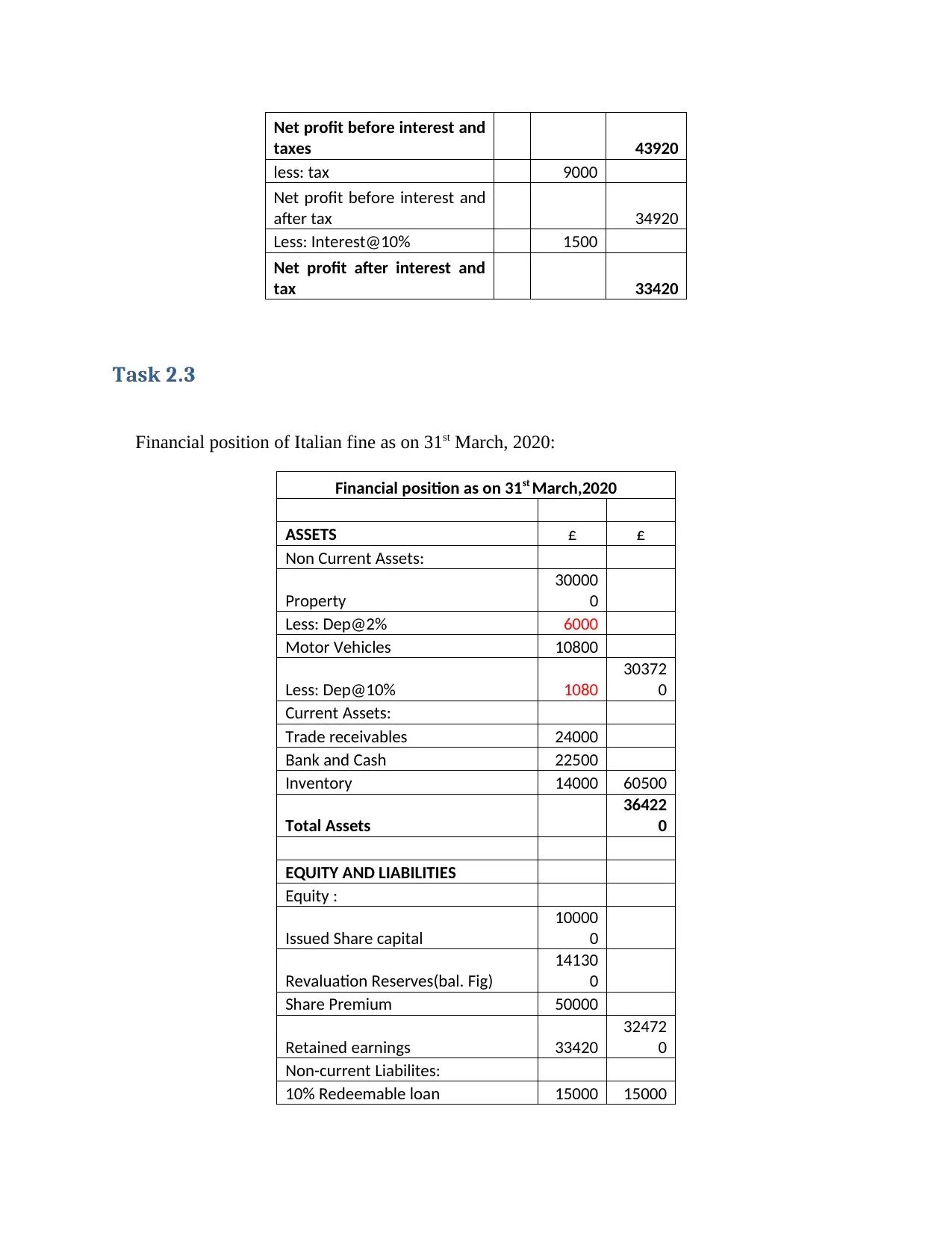
Net profit before interest and
taxes 43920
less: tax 9000
Net profit before interest and
after tax 34920
Less: Interest@10% 1500
Net profit after interest and
tax 33420
Task 2.3
Financial position of Italian fine as on 31st March, 2020:
Financial position as on 31st March,2020
ASSETS £ £
Non Current Assets:
Property
30000
0
Less: Dep@2% 6000
Motor Vehicles 10800
Less: Dep@10% 1080
30372
0
Current Assets:
Trade receivables 24000
Bank and Cash 22500
Inventory 14000 60500
Total Assets
36422
0
EQUITY AND LIABILITIES
Equity :
Issued Share capital
10000
0
Revaluation Reserves(bal. Fig)
14130
0
Share Premium 50000
Retained earnings 33420
32472
0
Non-current Liabilites:
10% Redeemable loan 15000 15000
taxes 43920
less: tax 9000
Net profit before interest and
after tax 34920
Less: Interest@10% 1500
Net profit after interest and
tax 33420
Task 2.3
Financial position of Italian fine as on 31st March, 2020:
Financial position as on 31st March,2020
ASSETS £ £
Non Current Assets:
Property
30000
0
Less: Dep@2% 6000
Motor Vehicles 10800
Less: Dep@10% 1080
30372
0
Current Assets:
Trade receivables 24000
Bank and Cash 22500
Inventory 14000 60500
Total Assets
36422
0
EQUITY AND LIABILITIES
Equity :
Issued Share capital
10000
0
Revaluation Reserves(bal. Fig)
14130
0
Share Premium 50000
Retained earnings 33420
32472
0
Non-current Liabilites:
10% Redeemable loan 15000 15000
Paraphrase This Document
Need a fresh take? Get an instant paraphrase of this document with our AI Paraphraser
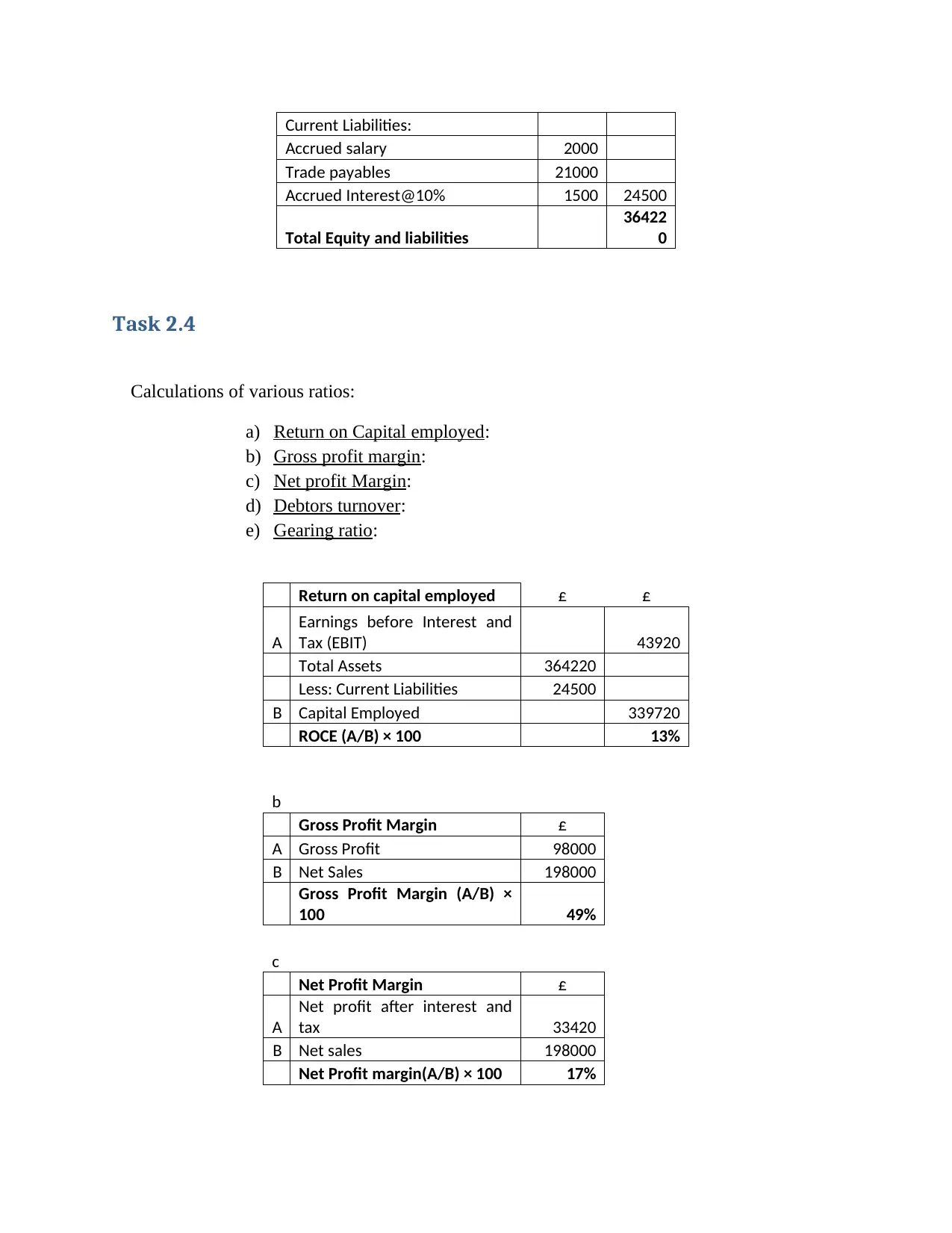
Current Liabilities:
Accrued salary 2000
Trade payables 21000
Accrued Interest@10% 1500 24500
Total Equity and liabilities
36422
0
Task 2.4
Calculations of various ratios:
a) Return on Capital employed:
b) Gross profit margin:
c) Net profit Margin:
d) Debtors turnover:
e) Gearing ratio:
Return on capital employed £ £
A
Earnings before Interest and
Tax (EBIT) 43920
Total Assets 364220
Less: Current Liabilities 24500
B Capital Employed 339720
ROCE (A/B) × 100 13%
b
Gross Profit Margin £
A Gross Profit 98000
B Net Sales 198000
Gross Profit Margin (A/B) ×
100 49%
c
Net Profit Margin £
A
Net profit after interest and
tax 33420
B Net sales 198000
Net Profit margin(A/B) × 100 17%
Accrued salary 2000
Trade payables 21000
Accrued Interest@10% 1500 24500
Total Equity and liabilities
36422
0
Task 2.4
Calculations of various ratios:
a) Return on Capital employed:
b) Gross profit margin:
c) Net profit Margin:
d) Debtors turnover:
e) Gearing ratio:
Return on capital employed £ £
A
Earnings before Interest and
Tax (EBIT) 43920
Total Assets 364220
Less: Current Liabilities 24500
B Capital Employed 339720
ROCE (A/B) × 100 13%
b
Gross Profit Margin £
A Gross Profit 98000
B Net Sales 198000
Gross Profit Margin (A/B) ×
100 49%
c
Net Profit Margin £
A
Net profit after interest and
tax 33420
B Net sales 198000
Net Profit margin(A/B) × 100 17%
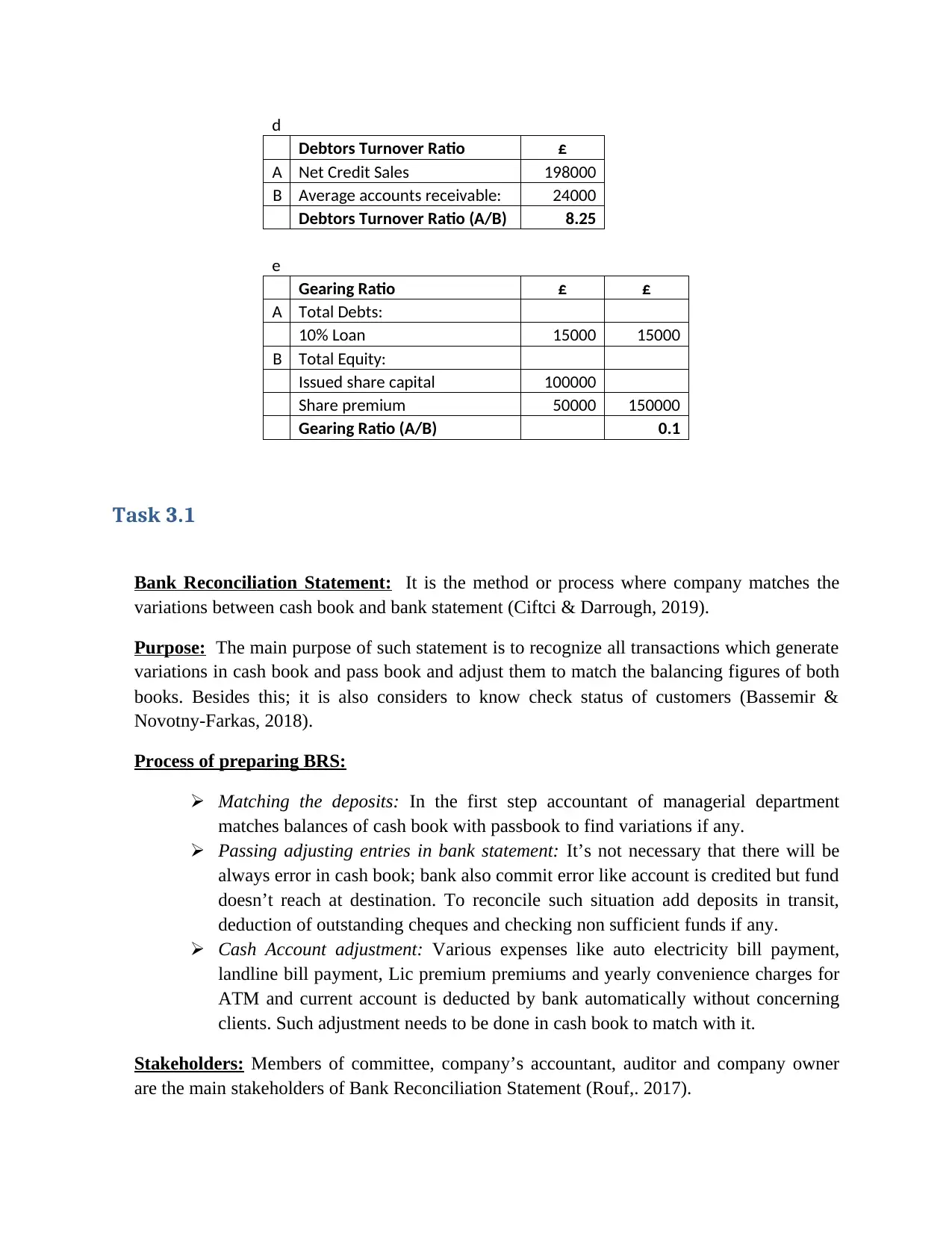
d
Debtors Turnover Ratio £
A Net Credit Sales 198000
B Average accounts receivable: 24000
Debtors Turnover Ratio (A/B) 8.25
e
Gearing Ratio £ £
A Total Debts:
10% Loan 15000 15000
B Total Equity:
Issued share capital 100000
Share premium 50000 150000
Gearing Ratio (A/B) 0.1
Task 3.1
Bank Reconciliation Statement: It is the method or process where company matches the
variations between cash book and bank statement (Ciftci & Darrough, 2019).
Purpose: The main purpose of such statement is to recognize all transactions which generate
variations in cash book and pass book and adjust them to match the balancing figures of both
books. Besides this; it is also considers to know check status of customers (Bassemir &
Novotny‐Farkas, 2018).
Process of preparing BRS:
Matching the deposits: In the first step accountant of managerial department
matches balances of cash book with passbook to find variations if any.
Passing adjusting entries in bank statement: It’s not necessary that there will be
always error in cash book; bank also commit error like account is credited but fund
doesn’t reach at destination. To reconcile such situation add deposits in transit,
deduction of outstanding cheques and checking non sufficient funds if any.
Cash Account adjustment: Various expenses like auto electricity bill payment,
landline bill payment, Lic premium premiums and yearly convenience charges for
ATM and current account is deducted by bank automatically without concerning
clients. Such adjustment needs to be done in cash book to match with it.
Stakeholders: Members of committee, company’s accountant, auditor and company owner
are the main stakeholders of Bank Reconciliation Statement (Rouf,. 2017).
Debtors Turnover Ratio £
A Net Credit Sales 198000
B Average accounts receivable: 24000
Debtors Turnover Ratio (A/B) 8.25
e
Gearing Ratio £ £
A Total Debts:
10% Loan 15000 15000
B Total Equity:
Issued share capital 100000
Share premium 50000 150000
Gearing Ratio (A/B) 0.1
Task 3.1
Bank Reconciliation Statement: It is the method or process where company matches the
variations between cash book and bank statement (Ciftci & Darrough, 2019).
Purpose: The main purpose of such statement is to recognize all transactions which generate
variations in cash book and pass book and adjust them to match the balancing figures of both
books. Besides this; it is also considers to know check status of customers (Bassemir &
Novotny‐Farkas, 2018).
Process of preparing BRS:
Matching the deposits: In the first step accountant of managerial department
matches balances of cash book with passbook to find variations if any.
Passing adjusting entries in bank statement: It’s not necessary that there will be
always error in cash book; bank also commit error like account is credited but fund
doesn’t reach at destination. To reconcile such situation add deposits in transit,
deduction of outstanding cheques and checking non sufficient funds if any.
Cash Account adjustment: Various expenses like auto electricity bill payment,
landline bill payment, Lic premium premiums and yearly convenience charges for
ATM and current account is deducted by bank automatically without concerning
clients. Such adjustment needs to be done in cash book to match with it.
Stakeholders: Members of committee, company’s accountant, auditor and company owner
are the main stakeholders of Bank Reconciliation Statement (Rouf,. 2017).
⊘ This is a preview!⊘
Do you want full access?
Subscribe today to unlock all pages.

Trusted by 1+ million students worldwide
1 out of 18
Related Documents
Your All-in-One AI-Powered Toolkit for Academic Success.
+13062052269
info@desklib.com
Available 24*7 on WhatsApp / Email
![[object Object]](/_next/static/media/star-bottom.7253800d.svg)
Unlock your academic potential
Copyright © 2020–2025 A2Z Services. All Rights Reserved. Developed and managed by ZUCOL.




